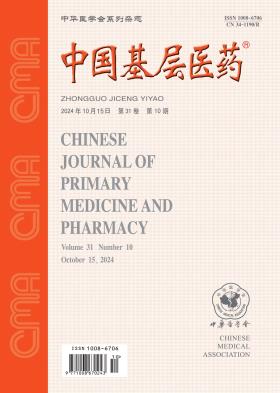Comparison of the effects of laparoscopic catheterization and surgical incision catheterization on catheter-related complications and microinflammation in uremic peritoneal dialysis patients
引用次数: 0
Abstract
Objective To compare the effects of laparoscopic and surgical catheterization on catheter-related complications and microinflammation in uremic peritoneal dialysis (PD) patients. Methods According to different catheterization methods, 98 uremic patients who were scheduled to undergo peritoneal dialysis in the First People's Hospital of Jiande from January 2014 to March 2019 were divided into group A (38 cases), group B (60 cases). Laparoscopic catheterization was used in group A, and incision catheterization was used in group B. Surgical parameters, catheter complications, microinflammation and survival rate of early catheterization were observed in the two groups. Results The operation time of group A was (35.00±3.14)min, which was shorter than that of group B [(50.00±5.17)min], and the operation cost of group A was (5 800.0±318.9)CNY, which was higher than that of group B [(3 400.0±297.4)CNY], and the visual analogue score (VAS) of group A was (2.33±0.31)points, which was lower than that of group B [(3.25±0.49)points], there were statistically significant differences between the two groups (t=11.540, 9.317, 10.328, 36.578, all P 0.05). After catheterization, the levels of hs-CRP, IL-6 and TNF-alpha in group B were (12.52±3.75)mg/L, (12.02±3.76)ng/L, (15.92±5.72)ng/L, respectively, which were higher than those in group A [(9.63±2.36)mg/L, (9.11±3.54)ng/L, (13.41±5.61)ng/L] (t=4.244, 4.081, 4.510, all P<0.05). After 2 months of follow-up, the survival rate of dialysis tube technique was 89.47%(34/38) in group A and 71.67%(43/60) in group B, there was statistically significant difference between the two groups (χ2=4.382, P<0.05). Conclusion Application of laparoscopic catheterization in uremic PD patients has satisfactory effect, light pain, fewer complications, mild inflammation and high survival rate of early catheterization technology, which is worthy of clinical promotion. Key words: Uremia; Peritoneal dialysis; Laparoscopy; Catheterization; Postoperative complications; C-reactive protein; Interleukin-6; Tumor necrosis factor-alpha腹腔镜置管与手术切口置管对尿毒症腹膜透析患者置管相关并发症及微炎症的影响比较
目的比较腹腔镜与外科置管对尿毒症腹膜透析(PD)患者置管相关并发症及微炎症的影响。方法选取2014年1月~ 2019年3月建德市第一人民医院计划行腹膜透析的尿毒症患者98例,根据置管方式不同分为A组(38例)、B组(60例)。A组采用腹腔镜置管,b组采用切口置管,观察两组手术参数、导管并发症、微炎症及早期置管生存率。结果A组的操作时间(35.00±3.14)分钟,这是短于B组的(50.00±5.17)分钟,A组的操作成本是5(800.0±318.9)元,这是高于B组(400.0±297.4(3)元)和视觉模拟评分(血管)的A组(2.33±0.31)分,这是低于B组(3.25±0.49)分,两组有显著差异(t = 11.540, 9.317, 10.328, 36.578,所有P 0.05)。置管后B组hs-CRP、IL-6、tnf - α水平分别为(12.52±3.75)mg/L、(12.02±3.76)ng/L、(15.92±5.72)ng/L,均高于A组[(9.63±2.36)mg/L、(9.11±3.54)ng/L、(13.41±5.61)ng/L] (t=4.244、4.081、4.510,P均<0.05)。随访2个月后,A组透析管技术生存率为89.47%(34/38),B组为71.67%(43/60),两组比较差异有统计学意义(χ2=4.382, P<0.05)。结论应用腹腔镜置管技术治疗尿毒症患者效果满意,早期置管技术疼痛轻,并发症少,炎症轻微,成活率高,值得临床推广。关键词:尿毒症;腹膜透析;腹腔镜检查;导管插入术;术后并发症;c反应蛋白;白细胞介素- 6;肿瘤坏死因子
本文章由计算机程序翻译,如有差异,请以英文原文为准。
求助全文
约1分钟内获得全文
求助全文
来源期刊
CiteScore
0.10
自引率
0.00%
发文量
32251
期刊介绍:
Since its inception, the journal "Chinese Primary Medicine" has adhered to the development strategy of "based in China, serving the grassroots, and facing the world" as its publishing concept, reporting a large amount of the latest medical information at home and abroad, prospering the academic field of primary medicine, and is praised by readers as a medical encyclopedia that updates knowledge. It is a core journal in China's medical and health field, and its influence index (CI) ranks Q2 in China's academic journals in 2022. It was included in the American Chemical Abstracts in 2008, the World Health Organization Western Pacific Regional Medical Index (WPRIM) in 2009, and the Japan Science and Technology Agency Database (JST) and Scopus Database in 2018, and was included in the Wanfang Data-China Digital Journal Group and the China Academic Journal Comprehensive Evaluation Database.

 求助内容:
求助内容: 应助结果提醒方式:
应助结果提醒方式:


